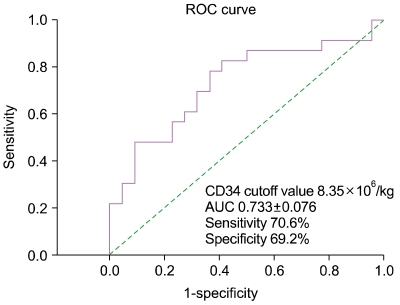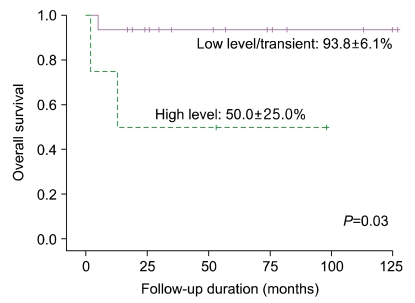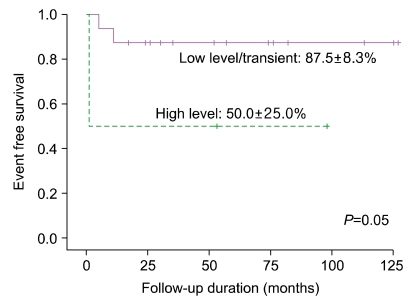Korean J Hematol.
2011 Dec;46(4):258-264. 10.5045/kjh.2011.46.4.258.
Clinical implications of chimerism after allogeneic hematopoietic stem cell transplantation in children with non-malignant diseases
- Affiliations
-
- 1Department of Pediatrics, College of Medicine, Chungbuk National University, Cheongju, Korea.
- 2Department of Pediatrics, Asan Medical Center Children's Hospital, University of Ulsan College of Medicine, Seoul, Korea. hojim@amc.seoul.kr
- KMID: 2251987
- DOI: http://doi.org/10.5045/kjh.2011.46.4.258
Abstract
- BACKGROUND
The effects of chimerism on outcomes following allogeneic hematopoietic stem cell transplantation (HSCT) are unclear and may differ between diseases. We retrospectively evaluated the association between chimerism and transplant outcomes in children with nonmalignant diseases.
METHODS
Chimerism was evaluated using short-tandem repeat polymerase chain reaction (STR-PCR) in 48 patients, with mixed chimerism (MC) defined as greater than 1% recipient cells.
RESULTS
The only variable exerting a significant influence on patients' chimerism status was the number of infused CD34+ cells. MC was detected in 23 transplants (9 showing transient MC; 10 with sustained low levels [< or =30%] of autologous cells; and 4 with high-level MC [>30%]). The degree of STR-PCR at 28 days after HSCT was significantly higher in patients with high-level MC than those with transient or low-level MC. All patients with transient or low-level MC successfully maintained engraftment and showed a clinical response to HSCT, whereas 2 of the 4 patients with high-level MC experienced graft failure. The incidences of grades II-IV acute and chronic graft-versus-host disease (GVHD) were significantly higher in patients with complete donor chimerism (CC) than MC. We observed no significant survival differences between CC and MC groups. However, the survival rate was lower in patients with high MC than those with low-level or transient MC (P=0.03).
CONCLUSION
In non-malignant diseases, MC may indicate a tolerant state with a decreased incidence of GVHD. However, high-level MC may signify an increased risk of graft failure and a lower survival rate.
MeSH Terms
Figure
Cited by 2 articles
-
Impact of Day 14 Peripheral Blood Chimerism after Allogeneic Hematopoietic Stem Cell Bone Transplantation on the Treatment Outcome of Non-Malignant Disease
Young Bae Choi, Ji Won Lee, Ki Woong Sung, Hong Hoe Koo, Hee-Jin Kim, Keon Hee Yoo
J Korean Med Sci. 2019;34(6):. doi: 10.3346/jkms.2019.34.e46.Rapid Determination of Chimerism Status Using Dihydrorhodamine Assay in a Patient with X-linked Chronic Granulomatous Disease Following Hematopoietic Stem Cell Transplantation
Hyun-Young Kim, Hee-Jin Kim, Chang-Seok Ki, Dae Won Kim, Keon Hee Yoo, Eun-Suk Kang
Ann Lab Med. 2013;33(4):288-292. doi: 10.3343/alm.2013.33.4.288.
Reference
-
1. Ringden O, Remberger M, Svahn BM, et al. Allogeneic hematopoietic stem cell transplantation for inherited disorders: experience in a single center. Transplantation. 2006; 81:718–725. PMID: 16534474.2. Peters C, Steward CG. Hematopoietic cell transplantation for inherited metabolic diseases: an overview of outcomes and practice guidelines. Bone Marrow Transplant. 2003; 31:229–239. PMID: 12621457.
Article3. Srinivasan R, Takahashi Y, McCoy JP, et al. Overcoming graft rejection in heavily transfused and allo-immunised patients with bone marrow failure syndromes using fludarabine-based haematopoietic cell transplantation. Br J Haematol. 2006; 133:305–314. PMID: 16643433.
Article4. McCann SR, Bacigalupo A, Gluckman E, et al. Graft rejection and second bone marrow transplants for acquired aplastic anaemia: a report from the Aplastic Anaemia Working Party of the European Bone Marrow Transplant Group. Bone Marrow Transplant. 1994; 13:233–237. PMID: 8199566.5. Bacigalupo A, Brand R, Oneto R, et al. Treatment of acquired severe aplastic anemia: bone marrow transplantation compared with immunosuppressive therapy-The European Group for Blood and Marrow Transplantation experience. Semin Hematol. 2000; 37:69–80. PMID: 10676912.
Article6. Lawler M, McCann SR, Marsh JC, et al. Serial chimerism analyses indicate that mixed haemopoietic chimerism influences the probability of graft rejection and disease recurrence following allogeneic stem cell transplantation (SCT) for severe aplastic anaemia (SAA): indication for routine assessment of chimerism post SCT for SAA. Br J Haematol. 2009; 144:933–945. PMID: 19183198.
Article7. Hoelle W, Beck JF, Dueckers G, et al. Clinical relevance of serial quantitative analysis of hematopoietic chimerism after allogeneic stem cell transplantation in children for severe aplastic anemia. Bone Marrow Transplant. 2004; 33:219–223. PMID: 14647253.
Article8. Willasch A, Hoelle W, Kreyenberg H, et al. Outcome of allogeneic stem cell transplantation in children with non-malignant diseases. Haematologica. 2006; 91:788–794. PMID: 16769581.9. Ferrara JL, Deeg HJ. Graft-versus-host disease. N Engl J Med. 1991; 324:667–674. PMID: 1994250.
Article10. Nollet F, Billiet J, Selleslag D, Criel A. Standardisation of multiplex fluorescent short tandem repeat analysis for chimerism testing. Bone Marrow Transplant. 2001; 28:511–518. PMID: 11593326.
Article11. Svenberg P, Mattsson J, Ringdén O, Uzunel M. Allogeneic hematopoietic SCT in patients with non-malignant diseases, and importance of chimerism. Bone Marrow Transplant. 2009; 44:757–763. PMID: 19421178.
Article12. Boelens JJ, Wynn RF, O'Meara A, et al. Outcomes of hematopoietic stem cell transplantation for Hurlers syndrome in Europe: a risk factor analysis for graft failure. Bone Marrow Transplant. 2007; 40:225–233. PMID: 17529997.
Article13. Ozyurek E, Cowan MJ, Koerper MA, Baxter-Lowe LA, Dvorak CC, Horn BN. Increasing mixed chimerism and the risk of graft loss in children undergoing allogeneic hematopoietic stem cell transplantation for non-malignant disorders. Bone Marrow Transplant. 2008; 42:83–91. PMID: 18391990.
Article14. Roy DC, Tantravahi R, Murray C, et al. Natural history of mixed chimerism after bone marrow transplantation with CD6-depleted allogeneic marrow: a stable equilibrium. Blood. 1990; 75:296–304. PMID: 1967216.
Article15. Baron F, Little MT, Storb R. Kinetics of engraftment following allogeneic hematopoietic cell transplantation with reducedintensity or nonmyeloablative conditioning. Blood Rev. 2005; 19:153–164. PMID: 15748963.
Article16. Sugita J, Tanaka J, Hashimoto A, et al. Influence of conditioning regimens and stem cell sources on donor-type chimerism early after stem cell transplantation. Ann Hematol. 2008; 87:1003–1008. PMID: 18636260.
Article17. Baron F, Maris MB, Storer BE, et al. High doses of transplanted CD34+ cells are associated with rapid T-cell engraftment and lessened risk of graft rejection, but not more graft-versus-host disease after nonmyeloablative conditioning and unrelated hematopoietic cell transplantation. Leukemia. 2005; 19:822–828. PMID: 15772701.
Article18. Mickelson DM, Sproat L, Dean R, et al. Comparison of donor chimerism following myeloablative and nonmyeloablative allogeneic hematopoietic SCT. Bone Marrow Transplant. 2011; 46:84–89. PMID: 20305699.
Article19. Gonzalez-Vicent M, Diaz MA. Higher doses of CD34+ PBPC are associated with a rapid acquisition of full donor chimerism and lower risk of relapse after allogeneic transplantation in pediatric patients with hematological malignancies. J Pediatr Hematol Oncol. 2011; 33:185–189. PMID: 21325973.
Article20. Remberger M, Jaksch M, Uzunel M, Mattsson J. Serum levels of cytokines correlate to donor chimerism and acute graft-vs.-host disease after haematopoietic stem cell transplantation. Eur J Haematol. 2003; 70:384–391. PMID: 12756021.
Article21. Jillella AP, Shafer D, Klumpp TR, Emmons RV, Mangan KF. Mixed chimerism and graft failure following conditioning with the fludarabine and cyclophosphamide nonablative regimen; conversion to full donor chimerism. Am J Hematol. 2007; 82:419–426. PMID: 17211845.
Article22. Armand P, Kim HT, Cutler CS, et al. Prognostic impact of elevated pretransplantation serum ferritin in patients undergoing myeloablative stem cell transplantation. Blood. 2007; 109:4586–4588. PMID: 17234738.
Article
- Full Text Links
- Actions
-
Cited
- CITED
-
- Close
- Share
- Similar articles
-
- Erratum: Correction of Title: Impact of Day 14 Peripheral Blood Chimerism after Allogeneic Hematopoietic Stem Cell Bone Transplantation on the Treatment Outcome of Non-Malignant Disease
- Lineage-specific chimerism analysis in nucleated cells, T cells and natural killer cells after myeloablative allogeneic hematopoietic stem cell transplantation
- What should we consider in mixed chimerism after hematopoietic stem cell transplantation?
- Unusual isolated extramedullary relapse of acute lymphoblastic leukemia in the breast despite complete donor hematopoietic chimerism after allogeneic hematopoietic stem cell transplantation
- Impact of Day 14 Peripheral Blood Chimerism after Allogeneic Hematopoietic Stem Cell Bone Transplantation on the Treatment Outcome of Non-Malignant Disease





